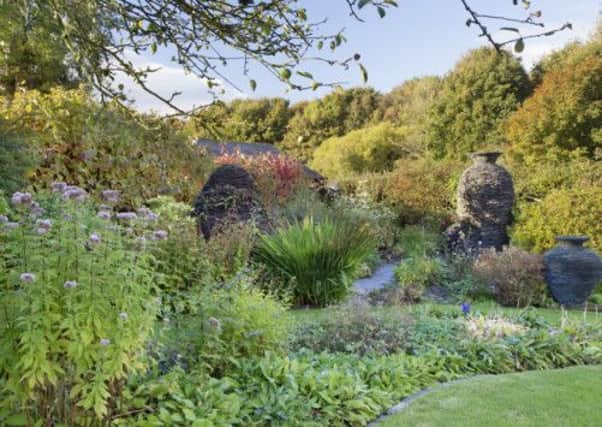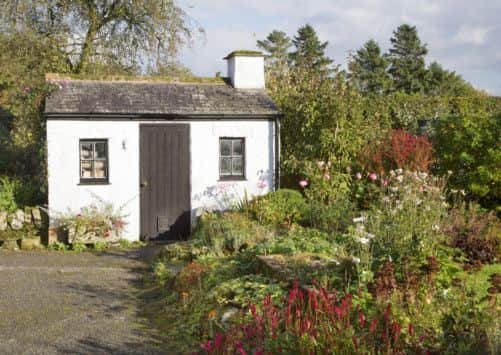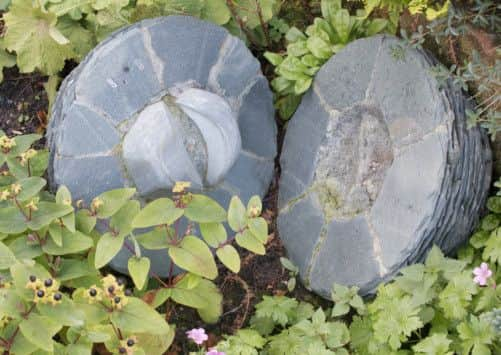Slate sculptures a solid foundation for garden


NESTLING among the plants at Joe Smith’s garden is a pear sculpted from slate. Perched on top of a pillar, a sphere sits like a planet tilting on its axis. The works are the marriage of decades of drystone dyking skill with art and, in the wet climate of Scotland, it is one of the best ways to enhance a garden.
Joe learned drystone dyking as a boy of 11 in Yorkshire and at the age of 13 built a henhouse with a slate roof. It sparked a lifelong passion for working with slate. From the age of 19 he worked building drystone walls and over the years has seen the use of the skill move from agricultural, to horticultural, architectural and finally sculptural. “To some extent it reflects an affluent period in history,” he says. “Interest in the arts recognised drystone walling as more than a means of keeping sheep out of the turnips, that it was beautiful. The art world started taking an interest in drystone walling, so I started taking an interest in art. It was a logical development in the skill.” Since the mid-Nineties, he has worked on creating slate sculptures for gardens, including in his own. The first large vase he created was as a gift for his wife, for their silver wedding anniversary, installing it in the garden as a surprise while she was away.
Advertisement
Hide AdAdvertisement
Hide AdThe effect of tightly layered slate is to look like woven fabric. The precision allows for clean-lined obelisks and elegantly curved vases. The shade in the recesses gives slate sculptures enormous presence at different times of the day – much like topiary – and in both natural and artificial light.


One of the beauties of slate as an ornament lies in the way it responds to rain – for once something that can be an asset in gardens. “When wet slate reflects the light it changes the colour and you can never recreate the way rain has fallen,” says Joe. One side of an ornament may be wet and the other dry, but the next time it rains it will look different. Layering the slate also harnesses light and shade to a much greater extent than with solid stone sculpture. “The intensity of shadow in the spaces in between the slate is just as important as the slate itself.”
Joe and his wife, Elizabeth, have lived at their Dumfriesshire cottage since 1982. They carved the beds out to make them deeper and to give Joe a workshop. Trevor Jones, prior to being head gardener of the NTS garden Threave, was a friend and suggested a planting scheme that the couple put into practice. Joe believes that placing sculptures next to shrubs and foliage is the best way to use them. In his own garden he has secluded them behind the bulk of trees and shrubs so that they reveal themselves. Ivy, ferns, and long-lasting herbaceous plants like geraniums and crocosmia offer a variety of foliage colour and texture to enhance the slate works. “They are very compatible with nature. If you put them in conjunction with foliage, then they are mutually complementary. I tend not to stick them in the middle of a lawn as a statement.”
His sculptures are the backbone of the garden, not just ornamentally but functionally. There is a gate clad with over-lapping tiles in the shape of dew drops. A curved column is topped with a bird feeding table and slate roof. There is a whinstone circle in which toads live. “I like to lay red dogwood stems in it in the spring and watch them change colour over the summer,” says Joe. Contrasting colours such as the red of bergenia, pink of persicaria, phlox, white cosmos and cotoneaster berries bring warmth and softness to the stone. “For a tall plant the spindly verbena bonariensis looks great, and in general lavenders, cat-mint and pink roses are my favourites, all of which, for some reason we struggle to grow well here. I love them with birch trees too.”
Having his own garden as a test bed for his work has allowed Joe to push the possibilities of the drystone technique. The cantilever effect of creating downward pressure over a central point keeps the structures stable and very heavy, but because they are built in tight layers can accommodate curves outwards that appear to defy gravity. His creations of pears, acorns and conkers have a little asymmetry as they would in nature, but Joe sometimes finds it more challenging to build in these deliberate imperfections than to create the perfect symmetry required for vases, spheres and chess pieces.


Large pieces are usually built on site as they are too heavy to move. They have to be big enough to be strong but can become heavy. The variety of objects that slate can be used to sculpt lends it to gardens of all sizes. Where a large stone sculpture might look out of place in a small garden, slate can deliver more subtlety and look more natural. “It can be the central point of a very small formal area like a parterre or seating area, or it can be part of a much bigger plan.” The sculptures work very well in Joe’s cottage garden, the house is blended with garden structures including large vases, or a column of spheres balancing on top of one another – they are bold, but not overpowering.
And there lies the essence of merging hard structures with plants – where one would look lost without the other.
For more information see joe-smith.co.uk